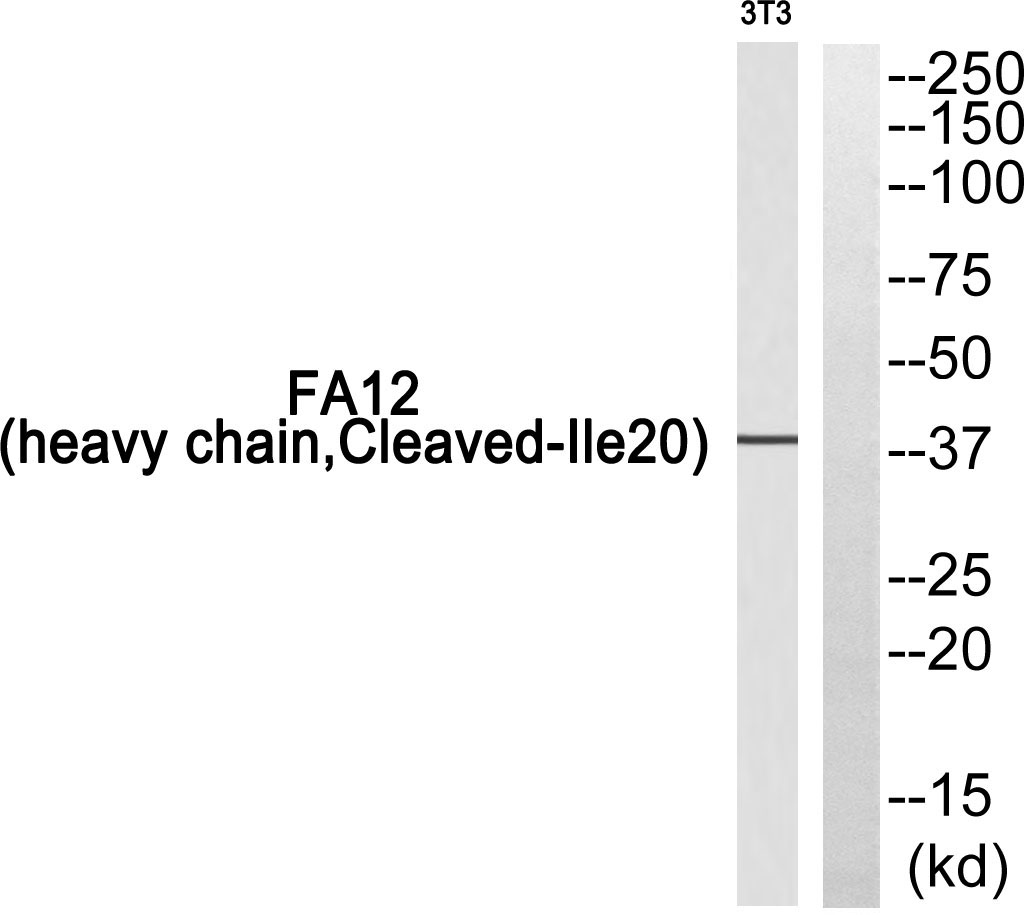Cleaved-Factor XII HC (I20) Polyclonal Antibody
- Catalog No.:YC0084
- Applications:WB;IHC;IF;ELISA
- Reactivity:Human;Rat;Mouse;
- Target:
- F12
- Fields:
- >>Complement and coagulation cascades
- Gene Name:
- F12
- Protein Name:
- Coagulation factor XII
- Human Gene Id:
- 2161
- Human Swiss Prot No:
- P00748
- Mouse Swiss Prot No:
- Q80YC5
- Immunogen:
- The antiserum was produced against synthesized peptide derived from human FA12. AA range:1-50
- Specificity:
- Cleaved-Factor XII HC (I20) Polyclonal Antibody detects endogenous levels of fragment of activated Factor XII HC protein resulting from cleavage adjacent to I20.
- Formulation:
- Liquid in PBS containing 50% glycerol, 0.5% BSA and 0.02% sodium azide.
- Source:
- Polyclonal, Rabbit,IgG
- Dilution:
- WB 1:500 - 1:2000. IHC 1:100 - 1:300. ELISA: 1:20000.. IF 1:50-200
- Purification:
- The antibody was affinity-purified from rabbit antiserum by affinity-chromatography using epitope-specific immunogen.
- Concentration:
- 1 mg/ml
- Storage Stability:
- -15°C to -25°C/1 year(Do not lower than -25°C)
- Other Name:
- F12;Coagulation factor XII;Hageman factor;HAF
- Molecular Weight(Da):
- 68kD
- Background:
- This gene encodes coagulation factor XII which circulates in blood as a zymogen. This single chain zymogen is converted to a two-chain serine protease with an heavy chain (alpha-factor XIIa) and a light chain. The heavy chain contains two fibronectin-type domains, two epidermal growth factor (EGF)-like domains, a kringle domain and a proline-rich domain, whereas the light chain contains only a catalytic domain. On activation, further cleavages takes place in the heavy chain, resulting in the production of beta-factor XIIa light chain and the alpha-factor XIIa light chain becomes beta-factor XIIa heavy chain. Prekallikrein is cleaved by factor XII to form kallikrein, which then cleaves factor XII first to alpha-factor XIIa and then to beta-factor XIIa. The active factor XIIa participates in the initiation of blood coagulation, fibrinolysis, and the generation of bradykinin and angiotensin. It activat
- Function:
- catalytic activity:Selective cleavage of Arg-|-Ile bonds in factor VII to form factor VIIa and factor XI to form factor XIa.,disease:Defects in F12 are the cause of factor XII deficiency (FA12D) [MIM:234000]; also known as Hageman factor deficiency. This trait is an asymptomatic anomaly of in vitro blood coagulation. Its diagnosis is based on finding a low plasma activity of the factor in coagulating assays. It is usually only accidentally discovered through pre-operative blood tests. F12 deficiency is divided into two categories, a cross-reacting material (CRM)-negative group (negative F12 antigen detection) and a CRM-positive group (positive F12 antigen detection).,disease:Defects in F12 are the cause of hereditary angioedema type 3 (HAE3) [MIM:610618]; also known as estrogen-related HAE or hereditary angioneurotic edema with normal C1 inhibitor concentration and function. HAE is chara
- Subcellular Location:
- Secreted.
- Expression:
- Blood,Lung,Plasma,
- June 19-2018
- WESTERN IMMUNOBLOTTING PROTOCOL
- June 19-2018
- IMMUNOHISTOCHEMISTRY-PARAFFIN PROTOCOL
- June 19-2018
- IMMUNOFLUORESCENCE PROTOCOL
- September 08-2020
- FLOW-CYTOMEYRT-PROTOCOL
- May 20-2022
- Cell-Based ELISA│解您多样本WB检测之困扰
- July 13-2018
- CELL-BASED-ELISA-PROTOCOL-FOR-ACETYL-PROTEIN
- July 13-2018
- CELL-BASED-ELISA-PROTOCOL-FOR-PHOSPHO-PROTEIN
- July 13-2018
- Antibody-FAQs
- Products Images

- Western blot analysis of FA12 (heavy chain, Cleaved-Ile20) Antibody. The lane on the right is blocked with the FA12 (heavy chain, Cleaved-Ile20) peptide.

- Immunohistochemistryt analysis of paraffin-embedded human lung carcinoma, using FA12 (heavy chain, Cleaved-Ile20) Antibody. The lane on the right is blocked with the FA12 (heavy chain, Cleaved-Ile20) peptide.



